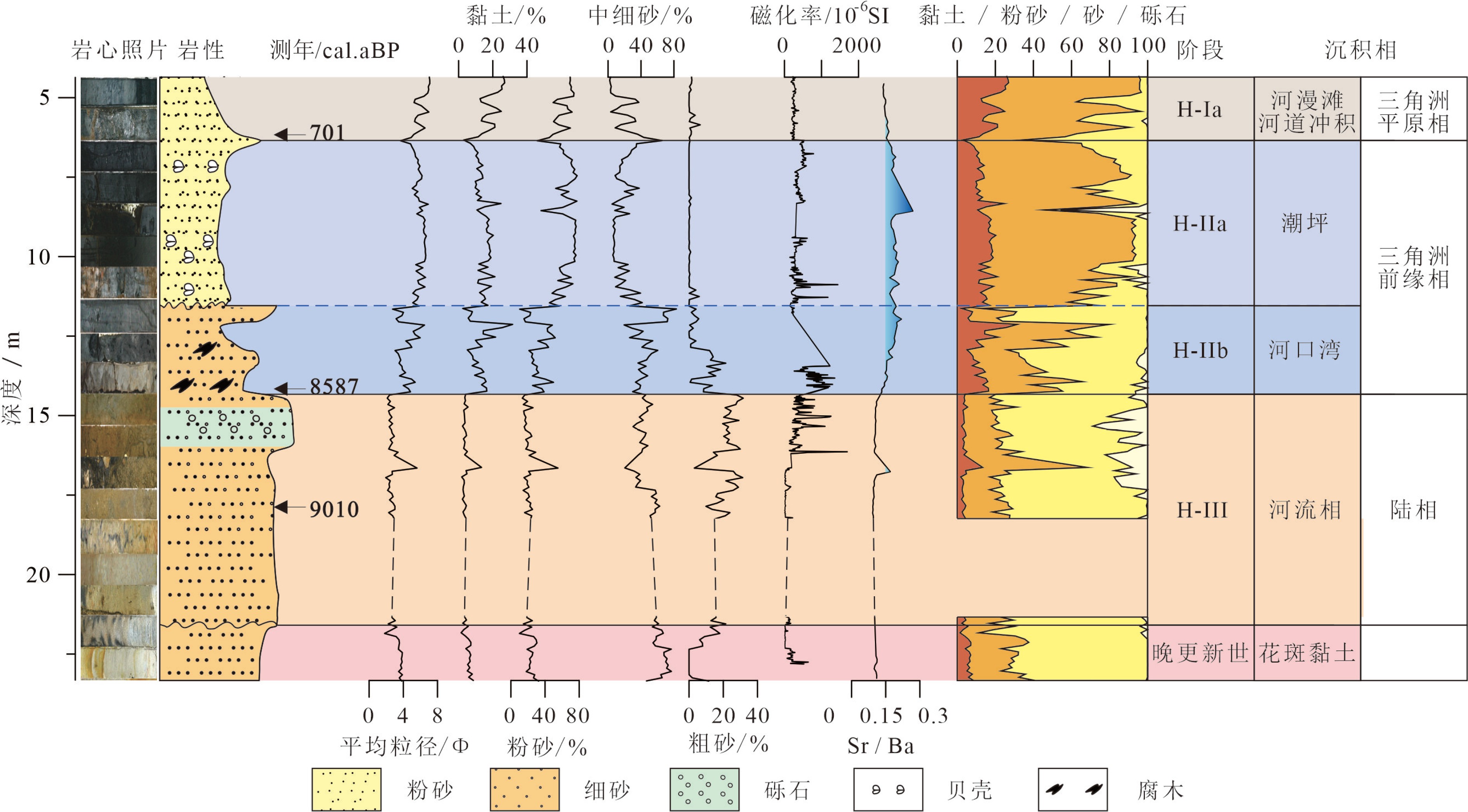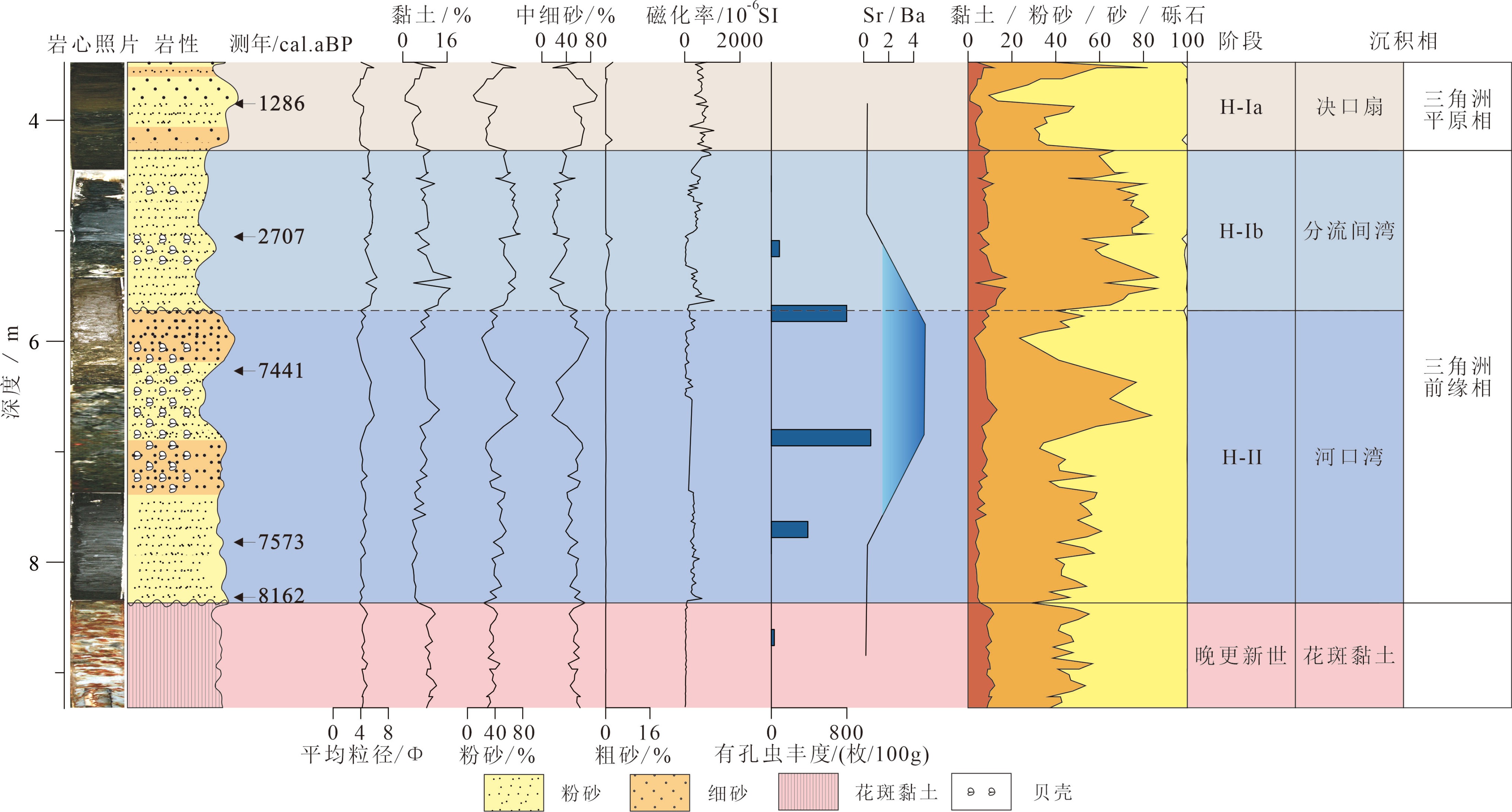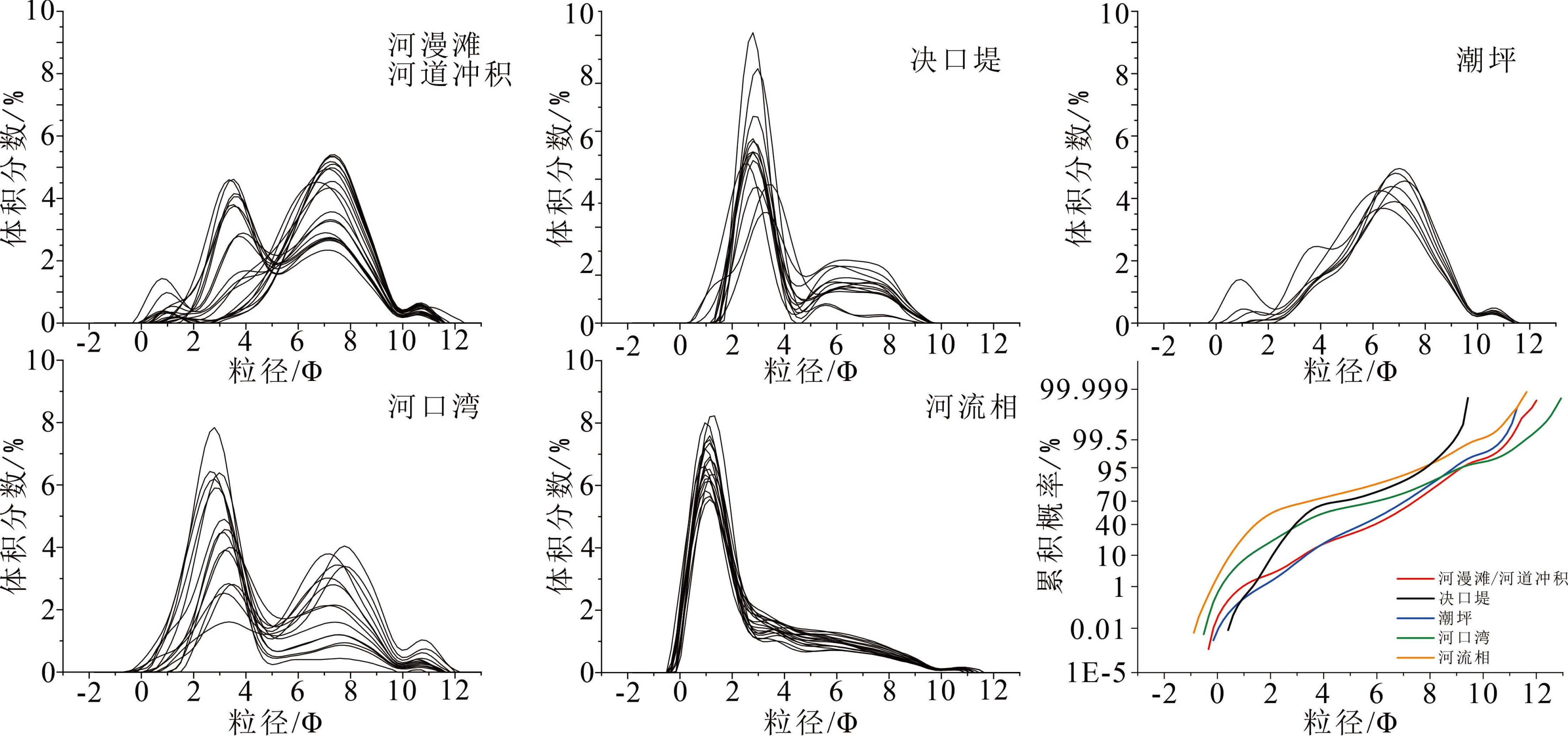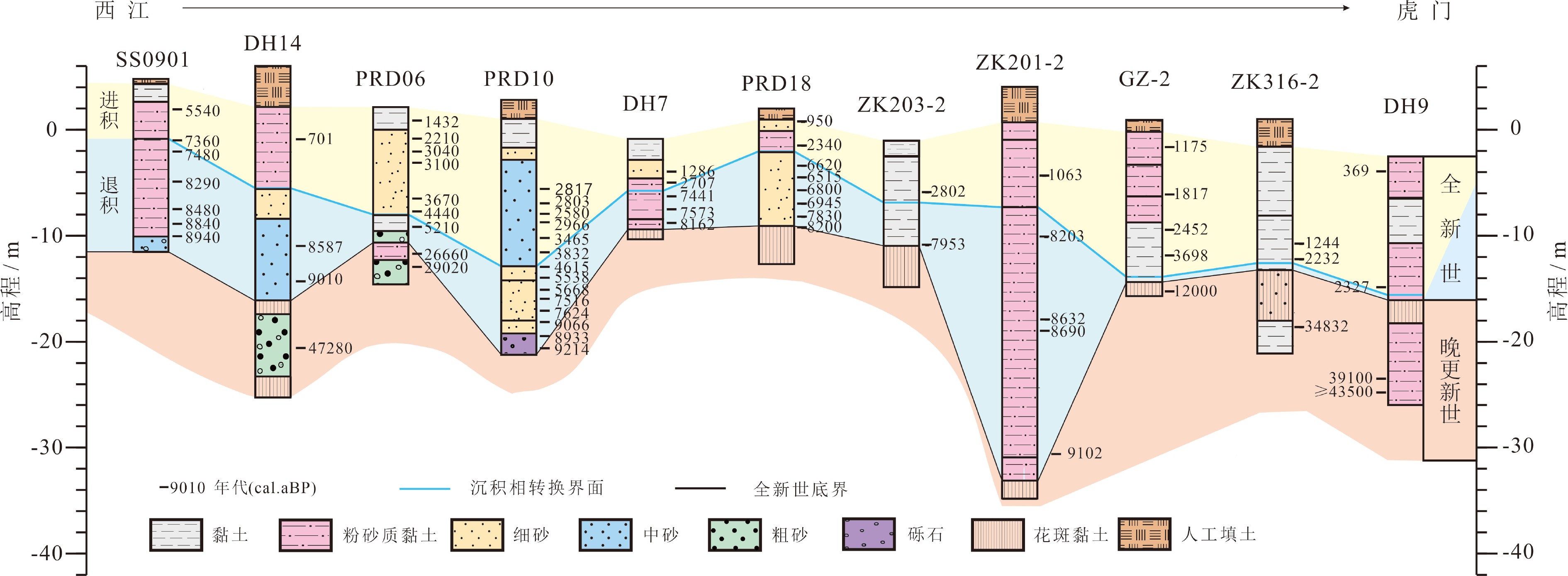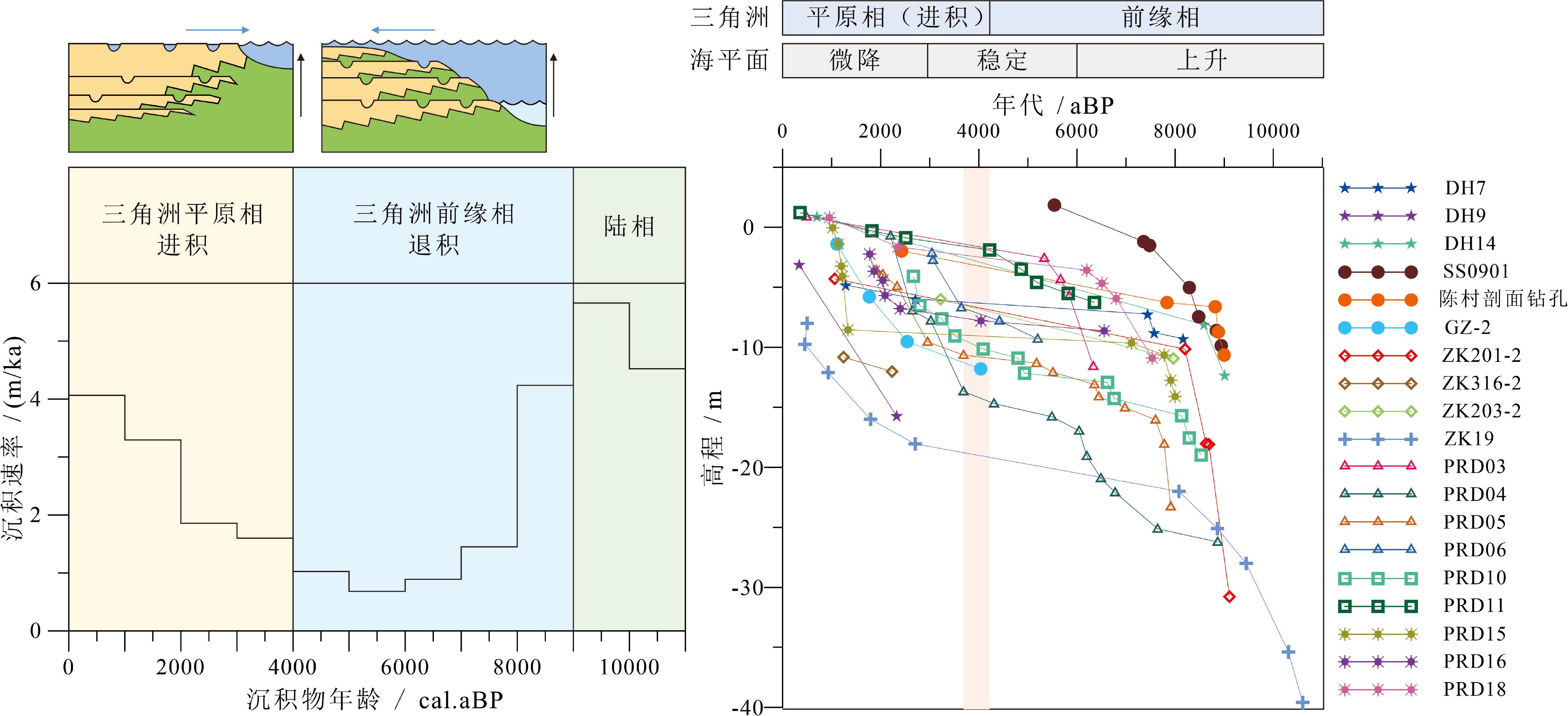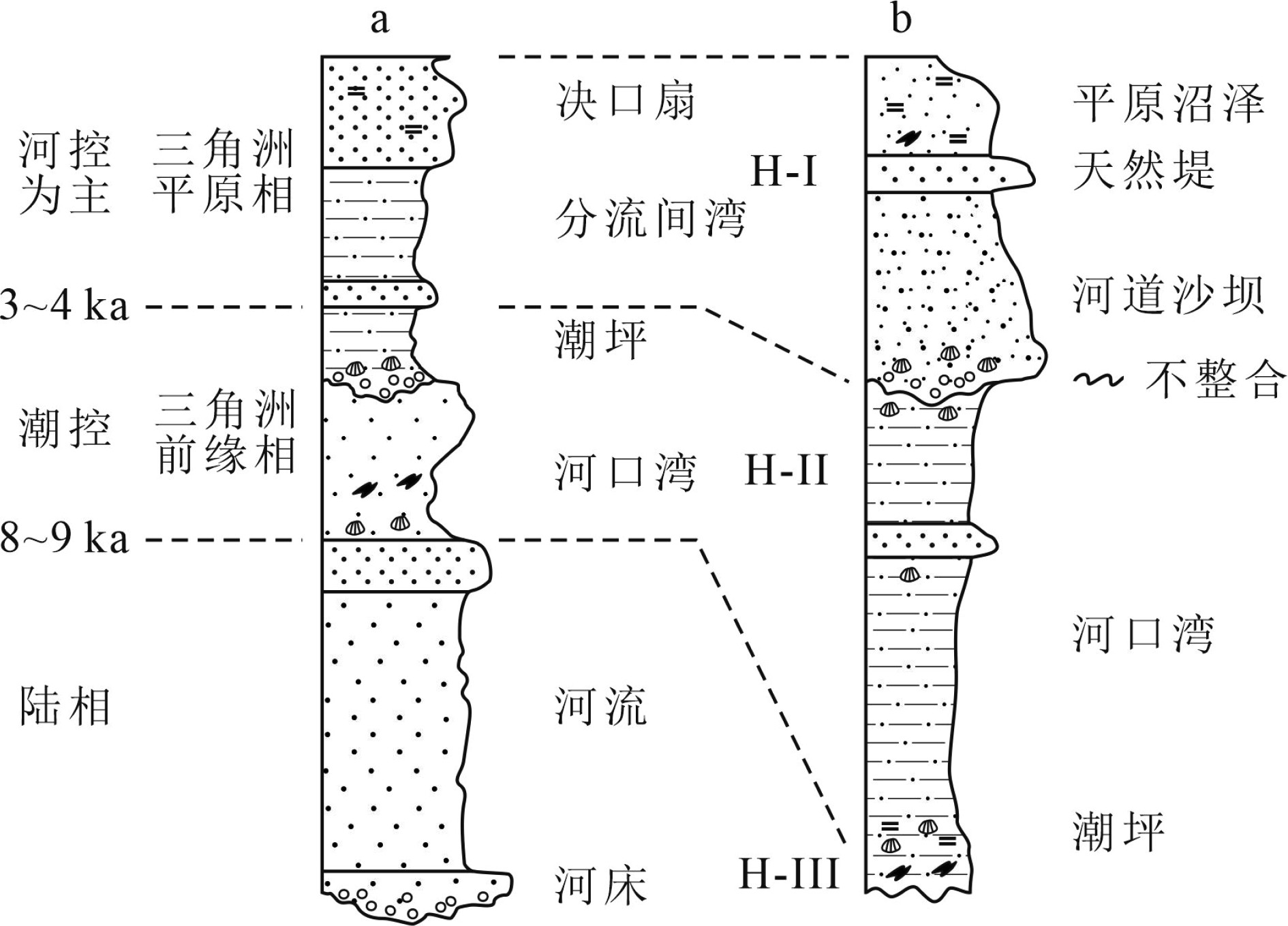Holocene sedimentary environment transform and onset time of Pearl River Delta progradation
-
摘要: 全新世是现代珠江三角洲平原形成的重要阶段,西江、北江和东江的河流物源为全新世海-陆交互相沉积提供了最主要的物质来源。然而,珠江三角洲早全新世以来的海进-海退沉积序列反映的沉积速率变化,以及退积-进积过程和起始年代因三角洲地区复杂的地形地貌而存在时空差异。此外,许多地点钻孔揭示出海-陆沉积模式转换过程中存在大量的沉积间断。本文对珠江三角洲的两个典型钻孔进行了详细的岩性、粒度等环境指标的分析,结合区域内20余个钻孔的横向对比,对全新世的海-陆沉积环境与模式转换进行了深入探讨。结果表明,全新世海相沉积底部年代为穿时性分布,在伶仃洋约为11 kaBP,海侵沿着深切河谷深入到番禺-三水一带的年代延迟至9~8 kaBP;高海面期不同地点存在三角洲前缘相的河口湾、潮坪等多种沉积环境,同时,早—中全新世三角洲前缘沉积环境受到古地形影响,在一些地点存在许多极高沉积速率的堆积体(可达~4 cm/a)。全新世沉积由海进的退积模式转变为海退的进积模式在大量钻孔中都有明显体现,通常表现为细粒组分的粉砂含量增多,磁化率快速升高,海洋有孔虫含量降低等;其沉积环境通常由滨海相转变为网状水系下的分流间湾、决口扇或河流冲积相。由潮汐作用为主的三角洲前缘沉积模式转换至平原相的发生时间主要集中在4~3 kaBP,并且许多地点的沉积动力转换的接触界面表现为明显的沉积间断,即晚全新世强烈的河流冲积和三角洲平原快速推进导致对原先较老沉积物的侵蚀作用。Abstract: The Pearl River Delta is mainly formed in Holocene by the sediments from the Xijiang, Beijiang and Dongjiang rivers as the results of sea-land interaction. Owing to the complexity of topography in the deltaic area, there remain some key questions to be solved, such as the spatio- temporal variation in depositional processes, onset time of delta progradation, variation in sedimentation rate and transgression -regression patterns. Boreholes at many sites have revealed that there are significant sedimentary discontinuities during the transformation from marine to fluvial environment and vice versa. In this paper, detailed investigation is devoted to the lithology, grain size distribution, magnetic susceptibility, microfossils and chronology of two typical cores, upon the correlation with over 20 cores from the region. Sea-land interaction models are established for the deltaic sequences. Results show that the age of the bottom of the marine sediments is diachronous from place to place. It is about 11 kaBP in the Lingding estuary, but 9~8 kaBP in the Panyu-Sanshui area due to the time delay during sea water transgression following the incised-valley; Various sedimentary environments such as estuaries and tidal flats as the components of the delta front facies appeared in different localities during high sea-level period. Affected by the land topography, sedimentation rate in some places may be as high as~4 cm/a. In many drilling holes, the transformation from marine progradation to retrogradation is often observed, while the fine sand components increase in contents, magnetic susceptibility rapidly increases, and the amount of ocean foraminifera decreases. At the same time, facies changes occur from coastal facies to tributary bays, crevasse splay, or river alluvial facies under a reticulated water system. The delta front facies, mostly tide-dominated, transformed to the delta plain facies around 4~3 kaBP, with distinct discontinuities, indicating the intensification of late Holocene underwater erosion by the Pearl River.
-
珠江三角洲第四系沉积物包括了晚更新统和全新统,其中的全新世海相沉积物分布广泛,其海侵范围的研究认为可深入到三角洲腹地[1-2]。三角洲的沉积发育阶段一般划分为三套地层单元,由老至新为横栏组、万顷沙组、灯笼沙组[1-4]。近几十年对珠江三角洲大量的岩芯沉积物的研究结果发现,全新统沉积比较复杂[5],空间相变大,不同沉积相地层存在穿时性,不同网状水系区域的沉积速率变化也很大,并揭露出普遍分布的沉积不连续[5-12]。总体上看,大量的年代学、沉积相、古生物化石、地球化学等研究表明,珠江三角洲形成的陆上平原主体经历了末次冰消期以来早—中全新世海侵和晚更新世海退的沉积序列变化[1, 4]。全新世沉积环境分为两个发育阶段,即海侵早期形成的河流—河口通道相砂质粉砂沉积,以及海平面趋于平稳后的三角洲粉砂与黏土沉积[5]。实际上,冰后期随着海平面的不断上升,在珠江三角洲地貌形态的影响下,海侵的界限在不同的空间和时间上变化大,导致不同地点的海相层沉积厚度的不同[13]。由于珠江三角洲由全新世海侵的退积沉积模式转换为进积的沉积模式在时间上和空间分布上目前仍缺乏系统的研究,本文针对珠江三角洲西北江下游的佛山、中山、南沙的钻孔进行年代学、粒度分析等新的高分辨率研究,结合已发表的钻孔分析测试结果,对全新世海侵-海退过程的沉积相变和相应年代进行了深入的分析。
1. 研究区域及钻孔材料
本次研究区域覆盖珠江三角洲大部分第四纪沉积区,主要以西江和北江流域下游为主(图1),该区属于亚热带季风气候温暖湿润,雨量充沛,年均降雨量1 600~2 600 mm,雨季多集中于高温季节,6—10月常常受到台风影响。珠江三角洲是由西江、北江以及东江形成的复合三角洲,河流总输沙量约为7 500×104 t/a[14]。其中西江的平均年径流为2 460亿m3,占珠江流域年通流(3 412亿m3)的72%,而北江、东江只分别占14%与9%,因此,珠江三角洲的发育是以西江径流为主要动力,以西江物源为主要物质。珠江三角洲复杂的岛屿状地形造成了沉积环境的区域差异性和独特性[15-17]。
本研究的典型钻孔为珠江三角洲的DH7和DH14钻孔(图1)的岩心沉积物。其中:
DH7号钻孔位于中山市三角镇沙栏村附近,距离现代伶仃洋西岸20 km左右,地理坐标为22°40′33.49″N、113°23′44.09″E,孔口标高1 m,岩芯总长20.35 m,其中深度0~3.47 m为人工填土层,深度3.35~8.38 m为全新统地层,深度8.38 m以下为花斑黏土层。
DH14号钻孔位于佛山市顺德区乐从镇良教村东南方向,地理坐标为22°57′49.47″N、113°03′39.45″E,距离西江20 km左右,孔口标高6 m,岩芯总长26.5 m,其中深度0~4.35 m为人工填土层,深度4.35~21.55 m为全新统地层,深度21.55 m以下为花斑黏土层。
为了进行区域横向对比,对已发表的20余个钻孔数据进行了沉积相、年代和沉积速率等综合对比(表1)。
表 1 本研究和引用的珠江三角洲剖面钻孔信息Table 1. Coordinates of study and sited cores from the Pearl River Delta in this work序号 钻孔编号 地点 孔口高程/m 北纬 东经 文献 1 SS0901 佛山市三水区 4.8 23°10′06.07″ 112°50′35.90″ [9] 2 陈村钻孔剖面 佛山市顺德区 2.4 22°58′35.00″ 113°12′28.00″ [18] 3 DH14 佛山市顺德区 5 22°57′49.47″ 113°03′39.45″ 本文 4 PRD09 广州市番禺区 1.07 22°55′20.00″ 113°25′39.00″ [19] 5 PRD15 广州市番禺区 − 22°54′49.00″ 113°31′02.00″ [20] 6 PRD16 广州市番禺区 1.73 22°52′28.00″ 113°32′45.00″ [21] 7 PRD20 佛山市顺德区 1.56 22°51′54.00″ 113°15′23.00″ [11] 8 PRD06 佛山市顺德区 2.73 22°51′18.00″ 113°08′40.00″ [20] 9 PRD10 中山市东凤镇 2.68 22°43′22.00″ 113°14′42.00″ [20] 10 GZ-2 广州市南沙区 1 22°42′20.34″ 113°30′49.86″ [22] 11 ZK201-2 中山市三角镇 4 22°41′03.12″ 113°27′25.20″ [23] 12 ZK316-2 广州市南沙区 1 22°40′52.00″ 113°35′06.00″ [10] 13 PRD18 中山市三角镇 2.02 22°40′41.00″ 113°25′55.00″ [20] 14 DH7 中山市三角镇 −1 22°40′33.49″ 113°23′44.09″ 本文 15 ZK203-2 中山市三角镇 −1 22°40′19.88″ 113°27′22.39″ [24] 16 PRD03 中山市小榄镇 − 22°39′11.02″ 113°16′17.40″ [20] 17 PRD11 中山市东升镇 − 22°37′58.00″ 113°16′58.00″ [20] 18 PRD02 中山市东升镇 2 22°37′05.40″ 113°17′21.05″ [25] 19 DH9 广州市南沙区 3 22°36′23.67″ 113°38′06.59″ 本文 20 PRD05 江门市新会区 1.12 22°31′24.00″ 113°11′02.00″ [7] 21 PRD04 江门市新会区 − 22°29′22.99″ 113°11′38.04″ [20] 22 ZK19 伶仃洋 −5 22°22′55.81″ 113°41′54.88″ [12] 2. 研究方法
对2条钻孔的岩芯沉积物样品进行粒度分析,共取252个样品,DH7、DH14岩芯沉积物样品的取样间隔分为5、10 cm。对每份样品烘干后称取0.5 g左右放置于离心管中,加入10 mL浓度为10%的过氧化氢,搅拌至样品充分反应为止,以去除样品中的有机质,然后加入10 mL浓度为20%的盐酸以去除样品中的碳酸盐以及铁质胶结物,搅拌并静置24 h,确认样品不再反应后加入蒸馏水洗涤,重复3遍至溶液呈中性为止。使用直径为1 000 μm的筛网筛出粒径>1 000 μm的颗粒并烘干称重,向<1 000 μm的样品中加入5 mL 0.05 mol/L的六偏磷酸钠溶液,搅拌并超声波震荡从而使样品在充分分散的状态上机测试。通过计算>1 000 μm的砾石颗粒样品与原样品的质量比测得砾石的质量分数。所有样品的粒度分析测试均在中山大学化学实验室完成,测试仪器使用的是英国Malvern 公司生产的Mastersizer 3000型激光粒度仪,每个样品重复进行3次测试并取其平均值。粒度分析数据均为激光粒度仪自动记录的各粒度组分含量数据,并对其进行统计分析。粒度分级标准使用的是尤登-温德华氏等比制Ф值粒度标准。粒度分析结果中,黏土、粉砂以及砂含量结果为激光粒度仪自动测得的体积分数。
对于沉积物的年代,本研究共采集了8个样品进行AMS 14C(Accelerator Mass Spectrometry,AMS)测试,由美国佛罗里达州迈阿密加速器实验室(Beta Analytic Radiocarbon Dating Laboratory,BETA)完成,日历年龄数据通过BetaCal 3.21的IntCal 13数据库进行校正。一个OSL(Optically Stimulated Luminescence)细砂样品由中山大学地球科学系同位素实验室完成,对样品中的粗颗粒石英进行OSL-SAR测试。
沉积物中的Sr与Ba元素的比值常常被用来指示样品的海陆相环境,黄镇国[26]、蓝先洪[27]等学者曾利用这两种地球化学元素的富集特征来判明珠江三角洲的沉积相;王建华[22]和瓦希拉里[12]等学者发现珠江三角洲海相沉积物的Sr / Ba值一般在约0.15以上。由于不同的黏土矿物能够吸附的化学元素组分有所不同,因此沉积物的地球化学元素组分主要受控于沉积介质中的黏土矿物种类,。本研究的沉积物样品先通过盐酸与硝酸混合液进行消解,然后采用电感耦合等离子体质谱仪(ICP-MS)检测痕量多元素含量。本研究的地球化学样品上机测试由澳实分析检测(广州)有限公司完成,测试方法代码为ME-MS41。
磁化率表示物质中铁磁性矿物的含量,可反映物源的矿物组成和沉积动力的变化,也在一定程度上反映气候变化和人类活动等综合信息[28-34],辅助粒度分析结果进行沉积环境判明以消除其多解性。王建华等学者对珠江三角洲第四纪沉积物研究发现,在粒度相同的情况下,海相沉积物的磁化率值较陆相沉积物高;而在相同沉积环境下,粉砂到细砂粒级沉积物的磁化率也比其他粒级的沉积物高[22]。本次对DH7、DH14钻孔进行了磁化率测试,测试间隔为2 cm,采用英国Bartington公司的MS2磁化率仪和MS2E探头。
此外,有孔虫广泛分布于海洋环境之中,对海陆交互相沉积环境的重建来说是重要的生物化石指标[35-37]。本研究采用了微体古生物分析方法,对DH7钻孔的岩芯沉积物样品进行了鉴定统计,基本流程如下:取100 g样品在60 ℃下烘干24 h随后称重,注水至没过样品并浸泡48 h使样品分散。将分散后的样品采用63 μm的铜筛进行过筛处理,保留并烘干筛上的样品,最后将各个样品置于Olympus体视显微镜下统计有孔虫数量。
3. 沉积相分析与沉积阶段
本次研究的钻孔DH7、DH14的年代框架主要通过AMS14C测年结果建立(表2),根据年代序列、沉积相时空分布和沉积速率变化,可划分为3个主要的三角洲沉积阶段(H-III,H-II,H-I),其中仅有DH14钻孔的全新世沉积物包含了全部的3个沉积阶段序列(图2)。此外,根据全新统沉积物粒度、微体古生物等特征,可综合区分为河流相、河口湾相、分流间湾浅滩相、决口扇与河漫滩相等沉积相类型(图2—4)。
表 2 DH7、DH14钻孔沉积物的测年结果Table 2. Information of age dating of samples from the cores DH7 and DH14取样编号 实验室编号 深度/m 测年材料 测试方法 测试年龄/aBP 校正年龄/cal. aBP(置信95%) DH7-1-50 Beta - 503602 3.85 贝壳 AMS 14C 1 810±30 1 384~1 188 DH7-2-66 5.01 有机质 AMS 14C 2 540±30 2 728~2 685 DH7-3-92 6.27 贝壳 AMS 14C 6 930±30 7 509~7 372 DH7-5-47 Beta - 503591 7.82 贝壳 AMS 14C 7 170±30 7 663~7 483 DH7-5-97 8.32 贝壳 AMS 14C 7 700±30 8 272~8 052 DH14-2-78 Beta - 503600 5.13 泥炭 AMS 14C 770±30 734~668 DH14-11-78 Beta - 503599 14.13 植物碎屑 AMS 14C 7 800±30 8 638~8 536 DH14-15 19CZ-24 19.30 粗颗粒石英 OSL-SAR 9 010±430 − 3.1 沉积相
河流沉积:以钻孔DH14为代表,沉积物一般为灰黄—黄褐色砂,通常含砾石。平均粒径为2.66Φ,变化范围为1.81~5.61Φ。在DH14钻孔该沉积相的平均粒径是整个钻孔沉积物最粗的一段,频率曲线(图3)显示该段呈现出正偏的窄峰,指示水动力条件比较单一。概率累积曲线显示跃移组分达到了50%以上,表示环境水动力条件较强,斜率达到50°~70°,代表了较好的分选性。磁化率值保持在5×10−4 SI以下的水平。此外,Sr / Ba比值一般均小于0.1,且波动不大。这些特征均表明该阶段尚未有海水侵入,以河流物源输入为主。
河口湾沉积:为灰黑—灰白色细砂和粉砂,略显沉积韵律,含有孔虫等海相微体化石,底部含腐木碎块。平均粒径为4.32~4.35Φ(DH14和DH7孔)。中细砂平均占50.64%(DH7)至46.58%(DH14),其次为粉砂(44%~32%)。沉积物的频率曲线(图3)显示出3Φ和8Φ两种峰的交替,即砂粒级的窄峰和粉砂粒级的宽峰同时出现,同时概率累积曲线显示跃移组分曲线为两段式,粒度变细的同时跃移组分也有所减少,说明此时受到海-陆两种水动力条件的共同作用。磁化率值约为2.28×10−4 SI,受到生物扰动影响可能出现波动以及峰值。有孔虫以滨海广盐型的毕克卷轮虫(Ammonia beccarii)和微温卷轮虫(Ammonia tepida)为主,两者丰度分别达到420.56枚 / 100 g和266.36枚 / 100 g,含少量适应于浅水型的少室卷轮虫(Ammonia pauciloculata)以及异地希望虫(Elphidium advenum),代表着水体为比较动荡的半咸水环境[38]。Sr / Ba比值为0.17~0.2,虽然达不到海洋沉积物的1以上,但相对于下覆陆相沉积偏高。
潮坪沉积:为灰黑色粉砂—细砂,见水平细层理,偶见波状纹层,常见贝壳等海生动物化石,含丰富的有孔虫和介形类。沉积物平均粒径为4.41~5.32Φ。粉砂的平均含量61%~42%,频率曲线呈现负偏态的宽峰,以细组分为主。概率累积曲线(图3)呈现出接近单段式的结果,或者为砂—粉砂的宽双峰形态,说明水动力条件较单一,可能为以潮汐波浪为主的水动力作用。显示跃移-推移组分仅占到了10%左右,交切点Φ值为2.3~3.2。磁化率值为4.29×10−4 SI左右。有孔虫的优势种主要为浅海相—半咸水型的异地希望虫(Elphidium advenum)和简单希望虫(Elphidium cf. Simplex),丰度均达到了343.75枚 / 100 g左右,亦含有广盐型的毕克卷轮虫(Ammonia beccarii),指示沉积环境有盐度上的波动变化。Sr / Ba比值接近0.2~0.3,其滨海沉积特征与有孔虫的丰度有较好的对应性(图4)。
三角洲平原沉积:主要见有河漫滩和决口扇沉积,本沉积相的磁化率值普遍较高,可达到6.27×10−4 SI左右,一般无有孔虫等海相化石。其中决口扇以黏土质粉砂为主,平均粒径较细(6.19Φ),粉砂含量达62.14%。决口扇相的概率累积曲线(图3)显示沉积物中的跃移组分达到了70%左右;频率分布曲线以3Φ的砂粒级窄峰为主,粉砂粒级次峰不明显,说明环境中水动力条件较强。河漫滩相的概率累积曲线(图3)呈现低斜多跳—悬式结构,显示跃移-推移组分含量不到10%,斜率达到10°~60°,分选较差,交切点Φ值为4.0~5.2;悬浮组分占到了90%以上,斜率40°左右,分选中等;频率曲线出现粉砂—黏土粒级的宽峰和砂粒级的宽峰两种情况,并有次峰。
3.2 主要沉积阶段
阶段H-III(约11~8.5 kaBP):该阶段以河流相为主,一些沉积层含有高有机质的灰黑色粉砂。在DH14孔的粗颗粒石英样品的OSL-SAR测年结果为9.01±0.43 kaBP。此阶段在三角洲靠近陆地一侧发育河流相沉积,但在南沙、伶仃洋、香港附近海域等地则见有海相沉积,表现出三角洲沉积环境在海侵过程中的空间差异性。此外,在一些冰期低海面深切河谷地段,海水入侵大约在9 kaBP已经深入陆地。
阶段H-II(8.5~4.0 kaBP):该阶段通常开始出现海相化石,广盐型的有孔虫数量剧增,说明该时期开始受到海水入侵的影响。Sr / Ba比值出现的递增趋势也表明了海洋的影响逐渐加强,磁化率值也因沉积动力由河流作用到海洋作用的改变而升高了一个数量级,同时主要的研究钻孔沉积相为三角洲前缘相的河口湾沉积环境。沉积物的概率累积曲线通常显示出两种峰(即砂粒级的窄峰和粉砂粒级的宽峰)的同时出现,证明该阶段海洋潮汐与河流水道的双重影响。有孔虫以Ammonia属有孔虫为主,其中Ammonia beccarii和Ammonia tepida为优势种,并开始出现少量生活于浅海环境的Elphidium advenum,此阶段的底栖有孔虫较为丰富,丰度和分异度也较高,在分布上与现代珠江三角洲河口湾较为相似[39],指示半咸水环境向浅海相环境的转变。这一阶段的沉积相在空间上也具有穿时性,如三水地区(SS0901孔)在8 kaBP以前仍为河流相沉积,随后开始有海侵的影响,沉积速率可达10 mm/a以上[11],海平面不断上升,使得沉积环境逐渐改变为海洋环境。
阶段H-I(4.0~0 kaBP):大部分区域为三角洲平原沉积,三角洲处于海退期的快速进积阶段。三角洲地区的磁化率值进一步提升,可能与细粒度组分的增加以及人类活动影响的增强有关,有孔虫优势种以A. beccarii和E. advenum为主,且该阶段有孔虫整体的丰度和分异度降低,但A. beccarii有增加的趋势,指示水体的盐度降低,同时水深变浅,说明开始向陆相环境转变[39]。虽然靠下游的区域仍然有海相沉积,但平原面上的钻孔揭示出河漫滩、决口扇、河道分流间湾等沉积环境。这一时期的沉积物常常平行不整合于下伏地层,显示出沉积模式转换过程中发生的侵蚀作用。
4. 全新世沉积模式及沉积相转换
三角洲的演变与全新世海平面快速上升以及随后的相对稳定密切相关。早中全新世海平面升高后海岸线大约在11 kaBP位于伶仃洋附近海域[40],本研究利用DH7、DH14钻孔以及前人研究的多个沉积序列以及测年结果较完整的典型钻孔组成西江至虎门出口一线的联合钻孔剖面(图5)进行对比,从剖面可以看出,珠江三角洲陆上平原的全新世底界一般分布在海拔−10 m至−20 m之间。最早进入现代珠江三角洲平原的海侵年代主要集中在10.5~9.0 kaBP,这个年代仅在个别钻孔出现,且其分布位置多在冰期过程的深切河谷内。随后,到大约8.5 kaBP海洋侵入三角洲大部分区域,并沿深切河谷进入三角洲腹地。约8.5 kaBP以后,海水开始入侵并由于河海相汇作用和三角洲复杂边界对河流和海洋动力的改造,使得高海面期三角洲的一些沉积中心分布在中部的不同区域[25],表明三角洲前缘相的沉积在不同的沉积区存在比较大的差异。从8.5 kaBP至4 kaBP的沉积物大多具有海相特征,同时在地层中发现有大量海生贝壳及微体古生物化石,有孔虫以广盐分子为主。而具有相对稳定的三角洲前缘相的滨海河口湾沉积的部分区域,其沉积厚度可超过10 m。
珠江三角洲的沉积模式早期为海侵过程的湾内充填型[41]的三角洲前缘相沉积,即由潮控为主的河口湾转变为河控为主的平原相沉积,主要沉积模式的转换发生在4 ka前后。但这种模式转换在空间上具有穿时性,即从上游往下游的发生时间为5.5~2 kaBP不等。在三角洲库容空间较小的情况下,大量的河流沉积物输入加速了三角洲的进积和平原的发展。晚全新世海平面较为稳定或略微下降也为快速进积提供了条件。本研究对具有14C年代数据的钻孔进行了沉积速率的计算和统计(图6),研究发现珠江三角洲平均沉积速率与前人的结果有较大差别,即中全新世高海面阶段按照深度/年代模式统计的沉积速率普遍偏小,如7~4 kaBP时间段的平均沉积速率为2.00 mm/a以下,比整个珠江三角洲海侵盛期以来的平均沉积速率2.52 mm/a还要低[42],而早(H-III)和晚(H-I)两个阶段的沉积速率较大。实际上,在从三角洲前缘相沉积模式转换为三角洲平原沉积模式的过程中,大约在4~3 ka之后强烈的网状支流河道冲积对原有的高海面沉积物产生巨大的侵蚀作用,有超过1/2的钻孔在沉积转换界面上存在沉积缺失或间断。也就是说,本研究计算的H-II阶段较低的沉积速率许多是由于沉积间断所造成,对于未被侵蚀且连续沉积的个别钻孔(如大鳌PRD04,三水SS0901)表现出三角洲前缘相早期沉积速率较高[43],随后至7~6 kaBP降低。如本研究的DH7钻孔H-II阶段沉积速率最高达11.65 mm/a,又如三水地区的8~7 kaBP沉积速率也达到12.79 mm/a[9],而5~4 kaBP的平均沉积速率降至<1 mm/a。可见,综合统计的中全新世H-II阶段较低的沉积速率部分是因为沉积缺失所造成。此外,由于珠江三角洲本身的复杂地形,使得古河口、古射流口、古汇潮点以及岛丘周围等泥沙容易落淤的部位的存在也是快速沉积体的主要形成原因[43]。
约4 kaBP以来的沉积环境转为三角洲平原相的进积沉积过程,沉积速率从之前的1 mm/a转变为增加的趋势,2 kaBP以后可达3~4 mm/a,该时期虽然在人类干扰的情况下地表侵蚀增大,但珠江输沙增多和快速进积作用仍然导致了三角洲平原的快速形成。同时,部分不整合界面的存在说明该时期的洪冲积广泛侵蚀了一些地区早期的全新世地层。由于三角洲平原的快速进积并迅速出露地表以及网状河道的形成、河口束窄,使得该阶段平均沉积速率并不是全新世中最高的。珠江三角洲全新世早期的古河道至古海湾沉积是由西北朝东南方向延伸,而始于~4 kaBP的西江径流和大量输沙的影响后,西北江三角洲下游河流逐步转向东西向发展。
对于全新世海进的退积,以及随后河口向海方向的进积过程和转换年代在空间上是存在差异性的,同时其在形成机制上存在不少争议。一些研究认为,全新世大暖期的结束和晚全新世季风减弱等气候变化因素可能是重要的驱动因素[44]。晚全新世大规模的洪水事件、更强的厄尔尼诺现象以及全球气候异常波动也可能与三角洲的快速进积有关[45-47]。实际上,三角洲发育的模式表明(图7),除了海平面变化作为主要的控制因素外,珠江三角洲近一万年来的沉积演替应属于潮控向河控发展的自然演替过程,典型区域的整体沉积过程经历了河-海-河的变化。
5. 结论
全新世是珠江三角洲平原形成的重要阶段,本研究通过钻孔岩芯沉积物的多指标分析,结合近些年一些较高分辨率的钻孔沉积物综合特征及年代-深度序列,对珠江三角洲全新世沉积模式以及环境演变进行了探讨,结果表明:
(1)珠江三角洲全新世沉积物普遍经历了3个沉积阶段:约11~8.5 kaBP,中山以北大部分地区以河流相沉积为主,现今番禺万顷沙及伶仃洋海域附近则发育海相沉积;8.5~4.0 kaBP左右,沉积相逐渐从河相过渡到海相,沉积物可能受到海洋潮汐与河流水道的双重影响;~4.0 kaBP以来,以粒度较细的三角洲平原沉积为主,同时沉积物多不整合于下伏地层之上。此外,3个沉积阶段的沉积速率也由于全新世海进退积向海退进积过程的转换以及古地形的影响而有明显的差异变化,陆相沉积物的沉积速率普遍较高。
(2)珠江三角洲全新世海侵过程具有空间差异性和穿时性。在8.5 kaBP以前,靠近陆地的三角洲地区主要以河流相沉积为主,而伶仃洋等海域则以海相沉积为主。与此同时,海拔低的地方接受海水侵入的时间就早,较早沉积的高程主要集中在海平面−10 m以下,底部年代在伶仃洋地区最早可达到11~12 kaBP左右,三水-番禺地区的深切河谷则要到9~8 kaBP左右才开始有海水入侵的沉积,而在三角洲进积过程中,潮控向河控模式的转变时间也因三角洲上游到下游的不同而出现4~2 kaBP的时间差异。
(3)珠江三角洲全新世海进的退积模式到海退的进积模式的转换在沉积物上主要体现为粒度组分变细,磁化率迅速升高,海洋微体古生物含量减少等,在沉积环境上则表现为从滨海相到分流间湾、决口扇或河流冲积相等偏陆相环境的转变,可见珠江三角洲的发育与海平面变化的影响密切。此外,潮控向河控发展的沉积演替的转换过程发生在5~3 kaBP期间,一些地区沉积物由于晚期河流冲积作用增强和三角洲快速进积而导致被剥蚀缺失,这也是本地区8.5~4 kaBP期间平均沉积速率较低的原因之一。
-
表 1 本研究和引用的珠江三角洲剖面钻孔信息
Table 1 Coordinates of study and sited cores from the Pearl River Delta in this work
序号 钻孔编号 地点 孔口高程/m 北纬 东经 文献 1 SS0901 佛山市三水区 4.8 23°10′06.07″ 112°50′35.90″ [9] 2 陈村钻孔剖面 佛山市顺德区 2.4 22°58′35.00″ 113°12′28.00″ [18] 3 DH14 佛山市顺德区 5 22°57′49.47″ 113°03′39.45″ 本文 4 PRD09 广州市番禺区 1.07 22°55′20.00″ 113°25′39.00″ [19] 5 PRD15 广州市番禺区 − 22°54′49.00″ 113°31′02.00″ [20] 6 PRD16 广州市番禺区 1.73 22°52′28.00″ 113°32′45.00″ [21] 7 PRD20 佛山市顺德区 1.56 22°51′54.00″ 113°15′23.00″ [11] 8 PRD06 佛山市顺德区 2.73 22°51′18.00″ 113°08′40.00″ [20] 9 PRD10 中山市东凤镇 2.68 22°43′22.00″ 113°14′42.00″ [20] 10 GZ-2 广州市南沙区 1 22°42′20.34″ 113°30′49.86″ [22] 11 ZK201-2 中山市三角镇 4 22°41′03.12″ 113°27′25.20″ [23] 12 ZK316-2 广州市南沙区 1 22°40′52.00″ 113°35′06.00″ [10] 13 PRD18 中山市三角镇 2.02 22°40′41.00″ 113°25′55.00″ [20] 14 DH7 中山市三角镇 −1 22°40′33.49″ 113°23′44.09″ 本文 15 ZK203-2 中山市三角镇 −1 22°40′19.88″ 113°27′22.39″ [24] 16 PRD03 中山市小榄镇 − 22°39′11.02″ 113°16′17.40″ [20] 17 PRD11 中山市东升镇 − 22°37′58.00″ 113°16′58.00″ [20] 18 PRD02 中山市东升镇 2 22°37′05.40″ 113°17′21.05″ [25] 19 DH9 广州市南沙区 3 22°36′23.67″ 113°38′06.59″ 本文 20 PRD05 江门市新会区 1.12 22°31′24.00″ 113°11′02.00″ [7] 21 PRD04 江门市新会区 − 22°29′22.99″ 113°11′38.04″ [20] 22 ZK19 伶仃洋 −5 22°22′55.81″ 113°41′54.88″ [12] 表 2 DH7、DH14钻孔沉积物的测年结果
Table 2 Information of age dating of samples from the cores DH7 and DH14
取样编号 实验室编号 深度/m 测年材料 测试方法 测试年龄/aBP 校正年龄/cal. aBP(置信95%) DH7-1-50 Beta - 503602 3.85 贝壳 AMS 14C 1 810±30 1 384~1 188 DH7-2-66 5.01 有机质 AMS 14C 2 540±30 2 728~2 685 DH7-3-92 6.27 贝壳 AMS 14C 6 930±30 7 509~7 372 DH7-5-47 Beta - 503591 7.82 贝壳 AMS 14C 7 170±30 7 663~7 483 DH7-5-97 8.32 贝壳 AMS 14C 7 700±30 8 272~8 052 DH14-2-78 Beta - 503600 5.13 泥炭 AMS 14C 770±30 734~668 DH14-11-78 Beta - 503599 14.13 植物碎屑 AMS 14C 7 800±30 8 638~8 536 DH14-15 19CZ-24 19.30 粗颗粒石英 OSL-SAR 9 010±430 − -
[1] 黄镇国, 李平日, 张仲英, 等. 珠江三角洲第四纪沉积特征[J]. 地质论评, 1985, 31(2):159-164. [HUANG Zhenguo, LI Pingri, ZHANG Zhongying, et al. Characteristics of the Quaternary deposits in the Zhujiang (Pearl) delta [J]. Geological Review, 1985, 31(2): 159-164. doi: 10.3321/j.issn:0371-5736.1985.02.008 [2] 郑卓, 汤永杰, 郑艳伟, 等. 西江―北江及珠江三角洲汇流区全新世泥炭腐木层时空分布与环境变化[J]. 热带地理, 2016, 36(3):313-325. [ZHENG Zhuo, TANG Yongjie, ZHENG Yanwei, et al. Environmental changes inferred from spatial-temporal distribution of Holocene buried peat layers in lower reaches of the Xijiang and Beijiang and the river confluence of Pearl River Delta [J]. Tropical Geography, 2016, 36(3): 313-325. [3] 陈国能, 张珂, 贺细坤, 等. 珠江三角洲晚更新世以来的沉积—古地理[J]. 第四纪研究, 1994(1):67-74. [CHEN Guoneng, ZHANG Ke, HE Xikun, et al. Paleo-geographic evolution of the Pearl River Delta since the Late Pleistocene [J]. Quaternary Sciences, 1994(1): 67-74. doi: 10.3321/j.issn:1001-7410.1994.01.007 [4] 李平日, 黄镇国, 张仲英, 等. 珠江三角洲的第四纪地层[J]. 地理科学, 1984, 4(2):133-142. [LI Pingri, HUANG Zhenguo, ZHANG Zhongying, et al. Quaternary stratigraphy in the Zhujiang Delta [J]. Scientia Geographica Sinica, 1984, 4(2): 133-142. [5] 宗永强, 黄光庆, 熊海仙, 等. 珠江三角洲晚第四纪地层、海平面变化与构造运动的关系[J]. 热带地理, 2016, 36(3):326-333. [ZONG Yongqiang, HUANG Guangqing, XIONG Haixian, et al. Relationship between Late Quaternary lithostratigraphy, sea-level change and tectonics in the Pearl River Delta [J]. Tropical Geography, 2016, 36(3): 326-333. [6] Zong Y Q, Yu F L, Huang G Q, et al. The history of water salinity in the Pearl River estuary, China, during the Late Quaternary [J]. Earth Surface Processes and Landforms, 2010, 35(10): 1221-1233. doi: 10.1002/esp.2030
[7] Liu C L, Fürsich F T, Wu J, et al. Late Quaternary palaeoenvironmental changes documented by microfaunas and shell stable isotopes in the southern Pearl River Delta plain, South China [J]. Journal of Palaeogeography, 2013, 2(4): 344-361.
[8] 陈双喜, 赵信文, 黄长生, 等. 珠江三角洲晚第四纪环境演化的沉积响应[J]. 地质通报, 2016, 35(10):1734-1744. [CHEN Shuangxi, ZHAO Xinwen, HUANG Changsheng, et al. Sedimentary response to the Late Quaternary envi-ronmental evolution in Pearl River Delta [J]. Geological Bulletin of China, 2016, 35(10): 1734-1744. doi: 10.3969/j.issn.1671-2552.2016.10.021 [9] 黄康有, 何嘉卉, 宗永强, 等. 珠江三角洲三水盆地早全新世以来孢粉分析与古环境重建[J]. 热带地理, 2016, 36(3):364-373. [HUANG Kangyou, HE Jiahui, ZONG Yongqiang, et al. Holocene paleoenvironment reconstruction based on pollen data in the Sanshui Basin, northern Pearl River Delta [J]. Tropical Geography, 2016, 36(3): 364-373. [10] 余少华, 陈芳, 谢叶彩, 等. 珠江口万顷沙晚第四纪沉积及古环境重建[J]. 热带地理, 2016, 36(3):374-387. [YU Shaohua, CHEN Fang, XIE Yecai, et al. Paleoenvironment reconstruction and sedimentary record in the Wanqingsha area of the Pearl River Estuary [J]. Tropical Geography, 2016, 36(3): 374-387. [11] 殷鉴, 刘春莲, 吴洁, 等. 珠江三角洲中部晚更新世以来的有孔虫记录与古环境演化[J]. 古地理学报, 2016, 18(4):677-690. [YIN Jian, LIU Chunlian, WU Jie, et al. Foraminiferal records and palaeoenvironmental changes since the Late Pleistocene in central Pearl River Delta [J]. Journal of Palaeogeography, 2016, 18(4): 677-690. doi: 10.7605/gdlxb.2016.04.050 [12] 瓦西拉里, 王建华, 陈慧娴, 等. 伶仃洋ZK19孔晚第四纪沉积地球化学特征及其古环境意义[J]. 热带地理, 2016, 36(3):343-354. [WAXI Lali, WANG Jianhua, CHEN Huixian, et al. Major and trace elements geochemistry and paleoenvironmental implications of borehole ZK19 in the Lingdingyang Bay of the Pearl River Estuary [J]. Tropical Geography, 2016, 36(3): 343-354. [13] 蓝先洪. 珠江三角洲晚第四纪沉积特征[J]. 沉积学报, 1996, 14(2):155-162. [LAN Xianhong. Sedimentary characteristics of Late Quaternary in the Zhujiang River Delta [J]. Acta Sedimentologica Sinica, 1996, 14(2): 155-162. [14] 戴仕宝, 杨世伦, 蔡爱民. 51年来珠江流域输沙量的变化[J]. 地理学报, 2007, 62(5):545-554. [DAI Shibao, YANG Shilun, CAI Aimin. Variation of sediment discharge of the Pearl River Basin from 1955 to 2005 [J]. Acta Geographica Sinica, 2007, 62(5): 545-554. doi: 10.3321/j.issn:0375-5444.2007.05.011 [15] 韦惺, 吴超羽. 珠江三角洲沉积体与河网干流河道的形成发育[J]. 海洋学报, 2018, 40(7):66-78. [WEI Xing, WU Chaoyu. The formation and development of the deposition bodies and main channels in the Zhujiang River Delta [J]. Haiyang Xuebao, 2018, 40(7): 66-78. [16] 黄镇国, 李平日, 张仲英, 等. 珠江三角洲形成发育演变[M]. 广州: 科学普及出版社广州分社, 1982. HUANG Zhenguo, LI Pingri, ZHANG Zhongying, et al. Evolution of the Pearl River Delta[M]. Guanzhou: Science Popularization Press Guangzhou Branch, 1982.
[17] 赵焕庭. 珠江河口演变[M]. 北京: 海洋出版社, 1990. ZHAO Huanting. Evolution of the Pearl River Estuary[M]. Beijing: China Ocean Press, 1990.
[18] 赵信文, 陈双喜, 黄长生, 等. 珠江三角洲陈村钻孔剖面沉积特征及有机碳同位素古环境意义[J]. 地质通报, 2014, 33(10):1635-1641. [ZHAO Xinwen, CHEN Shuangxi, HUANG Changsheng, et al. The sedimentary characteristics of core section from Chencun Village in Pearl River Delta, and their organic carbon isotopic palaeoenvironmental implications [J]. Geological Bulletin of China, 2014, 33(10): 1635-1641. doi: 10.3969/j.issn.1671-2552.2014.10.023 [19] 刘春莲, 杨婷婷, 吴洁, 等. 珠江三角洲晚第四纪风化层稀土元素地球化学特征[J]. 古地理学报, 2012, 14(1):125-132. [LIU Chunlian, YANG Tingting, WU Jie, et al. REE geochemical characteristics of mottled clays of the Late Quaternary in the Pearl River Delta [J]. Journal of Palaeogeography, 2012, 14(1): 125-132. doi: 10.7605/gdlxb.2012.01.011 [20] 韦惺. 全新世以来珠江三角洲的沉积演变模式研究[D]. 中山大学博士学位论文, 2010: 1-210. WEI Xing. Evolution pattern of the Zhujiang River Delta since Holocene[D]. Doctor Dissertation of Sun Yat-sen University, 2010: 1-210.
[21] 庄畅, 刘春莲, 吴洁, 等. 珠江三角洲PRD16孔微体生物记录与晚更新世以来的古环境重建[J]. 中山大学学报: 自然科学版, 2013, 52(3):128-132. [ZHUANG Chang, LIU Chunlian, WU Jie, et al. Microfossil records of borehole PRD16 and palaeoenvironment since the Late Pleistocene in the Pearl River Delta [J]. Acta Scientiarum Naturalium Universitatis Sunyatseni, 2013, 52(3): 128-132. [22] 王建华, 曹玲珑, 王晓静, 等. 珠江三角洲万顷沙地区晚第四纪沉积相与古环境演变[J]. 海洋地质与第四纪地质, 2009, 29(6):35-41. [WANG Jianhua, CAO Linglong, WANG Xiaojing, et al. Evolution of sedimentary facies and paleoenvironment during the Late Quaternary in Wanqingsha area of the Pearl River Delta [J]. Marine Geology & Quaternary Geology, 2009, 29(6): 35-41. [23] 陈炽新, 吴聪, 谢叶彩, 等. 珠江三角洲中山地区ZK201-2钻孔硅藻组合及古环境意义[J]. 微体古生物学报, 2014, 31(4):335-346. [CHEN Chixin, WU Cong, XIE Yecai, et al. Diatom assemblages from borehole ZK201-2 in Zhongshan area of the Zhujiang River Delta Guangdong, S. China and their paleoenvironment significance [J]. Acta Micropalaeontologica Sinica, 2014, 31(4): 335-346. [24] 谢叶彩, 王强, 龙桂, 等. 珠江口小榄镇-万顷沙地区晚更新世以来的海侵层序[J]. 古地理学报, 2014, 16(6):835-852. [XIE Yecai, WANG Qiang, LONG Gui, et al. Transgressive sequence since the Late Pleistocene in Xiaolan Town-Wanqingsha area, Zhujiang River estuary [J]. Journal of Palaeogeography, 2014, 16(6): 835-852. doi: 10.7605/gdlxb.2014.06.067 [25] 韦惺, 吴超羽. 全新世以来珠江三角洲的地层层序和演变过程[J]. 中国科学: 地球科学, 2011, 54(10):1523-1541. [WEI Xing, WU Chaoyu. Holocene delta evolution and sequence stratigraphy of the Pearl River Delta in South China [J]. Science China Earth Sciences, 2011, 54(10): 1523-1541. doi: 10.1007/s11430-011-4238-6 [26] 黄镇国, 李平日, 张仲英, 等. 珠江三角洲第四系微量元素的指相意义[J]. 热带地理, 1983(1):42-49, 53. [HUANG Zhenguo, LI Pingri, ZHANG Zhongying, et al. The referential phase significance of quaternary trace elements in the Pearl River Delta [J]. Tropical Geography, 1983(1): 42-49, 53. [27] 蓝先洪, 马道修, 徐明广, 等. 珠江三角洲若干地球化学标志及指相意义[J]. 海洋地质与第四纪地质, 1987, 7(1):41-51. [LAN Xianhong, MA Daoxiu, XU Mingguang, et al. Some geochemical indicators of the Pearl River Delta and their facies significance [J]. Marine Geology & Quaternary Geology, 1987, 7(1): 41-51. [28] Kissel C, Laj C, Mazaud A, et al. Magnetic anisotropy and environmental changes in two sedimentary cores from the Norwegian Sea and the North Atlantic [J]. Earth and Planetary Science Letters, 1998, 164(3-4): 617-626. doi: 10.1016/S0040-1951(98)00223-6
[29] 张振克, 吴瑞金, 王苏民. 岱海湖泊沉积物频率磁化率对历史时期环境变化的反映[J]. 地理研究, 1998, 17(3):297-302. [ZHANG Zhenke, WU Ruijin, WANG Sumin. Implication of magnetic frequency dependent susceptibility on environmental variation from lacustrine sediment in Daihai Lake [J]. Geographical Research, 1998, 17(3): 297-302. doi: 10.3321/j.issn:1000-0585.1998.03.011 [30] 杨晓强, 李华梅. 泥河湾盆地沉积物磁化率及粒度参数对沉积环境的响应[J]. 沉积学报, 1999, 17(S1):763-768. [YANG Xiaoqiang, LI Huamei. The sediment susceptibility and grain-size profile respond to change of depositional environment in Nihewan Basin [J]. Acta Sedimentologica Sinica, 1999, 17(S1): 763-768. [31] 吴海斌, 陈发虎, 王建民, 等. 干旱区湖泊沉积物磁组构参数量值特征与环境变化研究[J]. 海洋地质与第四纪地质, 1999, 19(2):95-102. [WU Haibin, CHEN Fahu, WANG Jianmin, et al. Study on magnetic fabric parameters of lake sediments in arid area and environmental changes [J]. Marine Geology & Quaternary Geology, 1999, 19(2): 95-102. [32] 杨晓强, 李华梅. 陆相断陷湖盆沉积物磁组构特征及环境意义——以泥河湾盆地为例[J]. 海洋地质与第四纪地质, 2000, 20(3):43-52. [YANG Xiaoqiang, LI Huamei. Magnetic anisotropy and its environmental significance in limnal faulted basin—Taking the Nihewan Basin as an example [J]. Marine Geology & Quaternary Geology, 2000, 20(3): 43-52. [33] 王秋良, 袁胜元, 李长安. 江汉平原江陵剖面有机碳含量、碳同位素和磁化率的古气候意义[J]. 地质科技情报, 2006, 25(4):59-62. [WANG Qiuliang, YUAN Shengyuan, LI Chang’an. Paleoclimate significance of the total organic carbon and organic carbon isotope and magnetic susceptibility of the Jiangling Section, Jianghan Plain, Hubei Province [J]. Geological Science and Technology Information, 2006, 25(4): 59-62. doi: 10.3969/j.issn.1000-7849.2006.04.011 [34] 张玉芬, 李长安, 王秋良, 等. 江汉平原沉积物磁学特征及对长江三峡贯通的指示[J]. 科学通报, 2008, 53(4):584-590. [ZHANG Yufen, LI Chang’an, WANG Qiuliang, et al. Magnetism parameters characteristics of drilling deposits in Jianghan Plain and indication for forming of the Yangtze River Three Gorges [J]. Chinese Science Bulletin, 2008, 53(4): 584-590. doi: 10.1007/s11434-008-0111-1 [35] 汪品先, 闵秋宝, 卞云华. 南黄海西北部底质中有孔虫、介形虫分布规律及其地质意义[M]//汪品先. 海洋微体古生物论文集. 北京: 海洋出版社, 1980. WANG Pinxian, MIN Qiubao, BIAN Yunhua. The distribution and geological significance of foraminifera and ostracoda in the sediment of the northwestern South Yellow Sea[M]//WANG Pinxian. Marine Microbody Paleontology. Beijing: China Ocean Press, 1980.
[36] Buck K F, C Olson H C, Austin J A Jr. Paleoenvironmental evidence for latest Pleistocene sea-level fluctuations on the New Jersey outer continental shelf: combining high-resolution sequence stratigraphy and foraminiferal analysis [J]. Marine Geology, 1999, 154(1-4): 287-304. doi: 10.1016/S0025-3227(98)00119-4
[37] Murray J W. Ecology and Applications of Benthic Foraminifera[M]. New York: Cambridge University Press, 2006.
[38] 董艺辛, 刘春莲, 阴家润, 等. 珠江三角洲晚第四纪环境演变的微体生物记录[J]. 古脊椎动物学报, 2007, 45(2):161-172. [DONG Yixin, LIU Chunlian, YIN Jiarun, et al. Late Quaternary microfaunas and paleoenvironmental changes recorded in core sediments of the Pearl River Delta, South China [J]. Vertebrata Palasiatica, 2007, 45(2): 161-172. doi: 10.3969/j.issn.1000-3118.2007.02.008 [39] 周洋, 谢叶彩, 陈芳, 等. 珠江三角洲ZK201-2孔晚更新世以来微体生物群与古环境[J]. 海洋地质与第四纪地质, 2015, 35(4):113-123. [ZHOU Yang, XIE Yecai, CHEN Fang, et al. Microfaunas in hole ZK201-2 at Zhujiang River Delta since late pleistocene and their implications for paleoenvironments [J]. Marine Geology & Quaternary Geology, 2015, 35(4): 113-123. [40] Zong Y Q, Huang K Y, Yu F L, et al. The role of sea-level rise, monsoonal discharge and the palaeo-landscape in the early Holocene evolution of the Pearl River delta, southern China [J]. Quaternary Science Reviews, 2012, 54: 77-88. doi: 10.1016/j.quascirev.2012.01.002
[41] 龙云作, 霍春兰. 珠江三角洲晚第四纪沉积特性[J]. 海洋科学, 1990(4):7-14. [LONG Yunzuo, HUO Chunlan. The sedimentation characteristics of Zhujiang River Delta in Late Quaternary [J]. Marine Sciences, 1990(4): 7-14. [42] 黄镇国, 宗永强. 应用粒度参数区分沉积相——以珠江三角洲为例[J]. 热带地理, 1982, 2(2):37-42. [HUANG Zhenguo, ZONG Yongqiang. The application of particle size parameters to distinguish sedimentary facies - A case study of the Pearl River Delta [J]. Tropical Geography, 1982, 2(2): 37-42. [43] 贾良文, 何志刚, 莫文渊, 等. 全新世以来珠江三角洲快速沉积体的初步研究[J]. 海洋学报, 2010, 32(2):87-95. [JIA Liangwen, HE Zhigang, MO Wenyuan, et al. A preliminary study on rapid deposition bodies in the Zhujiang Delta since Holocene [J]. Acta Oceanologica Sinica, 2010, 32(2): 87-95. [44] 王晓静, 王建华, 曹玲珑, 等. 广州地区晚第四纪孢粉气候研究[J]. 中山大学学报: 自然科学版, 2010, 49(3):113-121. [WANG Xiaojing, WANG Jianhua, CAO Linglong, et al. Late Quaternary pollen records and climate significance in Guangzhou [J]. Acta Scientiarum Naturalium Universitatis Sunyatseni, 2010, 49(3): 113-121. [45] 张生, 朱诚, 张强, 等. 太湖地区新石器时代以来文化断层的成因探讨[J]. 南京大学学报: 自然科学版, 2002, 38(1):64-73. [ZHANG Sheng, ZHU Cheng, ZHANG Qiang, et al. Cultural interruptions since the Neolithic Age recorded in the Diagnostic sediment in the Taihu Lake region, Esastern China [J]. Journal of Nanjing University: Natural Sciences, 2002, 38(1): 64-73. [46] 张强, 姜彤, 施雅风, 等. 长江三角洲地区1万年以来洪水与气候变化的关系[J]. 海洋地质与第四纪地质, 2003, 23(3):11-15. [ZHANG Qiang, JIANG Tong, SHI Yafeng, et al. Relationship between climatic changes and the flooding occurrence since the Holocene in the Yangtze River Delta region [J]. Marine Geology & Quaternary Geology, 2003, 23(3): 11-15. [47] 张强, 朱诚, 姜逢清, 等. 南京江北地区晚更新世以来环境演变研究[J]. 地理科学, 2001, 21(6):498-504. [ZHANG Qiang, ZHU Cheng, JIANG Fengqing, et al. Environmental changes since Late-Pleistocene in north-bank of Yangtze River, Nanjing [J]. Scientia Geographica Sinica, 2001, 21(6): 498-504. doi: 10.3969/j.issn.1000-0690.2001.06.004 -
期刊类型引用(5)
1. 郑卓,马婷,汤永杰,Barry V.Rolett,宗永强,黄康有,万秋池,陈聪,张潇,陈碧珊,张绍轩. 华南至东南亚沿海全新世环境演变与史前农业. 科学通报. 2024(18): 2553-2567 .  百度学术
百度学术
2. 王媛媛,勾松林,张国成. 现代珠江三角洲前缘生物遗迹组成与分布特征. 沉积学报. 2024(05): 1512-1529 .  百度学术
百度学术
3. 陆虹宇,姜守俊,黄孔文,陈聪,汤永杰,李宏卫,黄屏,黄康有. 珠江三角洲晚第四纪沉积序列及其对海侵过程的响应. 海洋地质与第四纪地质. 2023(02): 18-30 .  本站查看
本站查看
4. 陈国生,邱梓惠,孔德明. 正构烷烃组成的古环境指示:以中全新世以来珠江口沉积物研究为例. 海洋学研究. 2023(01): 121-130 .  百度学术
百度学术
5. 曹凯君,任晋珂,李潇濛,吴怀春,陈芳,余少华,时美楠,甘华阳. 珠江口伶仃洋ZK1钻孔的磁性地层学研究. 现代地质. 2022(01): 58-67 .  百度学术
百度学术
其他类型引用(6)



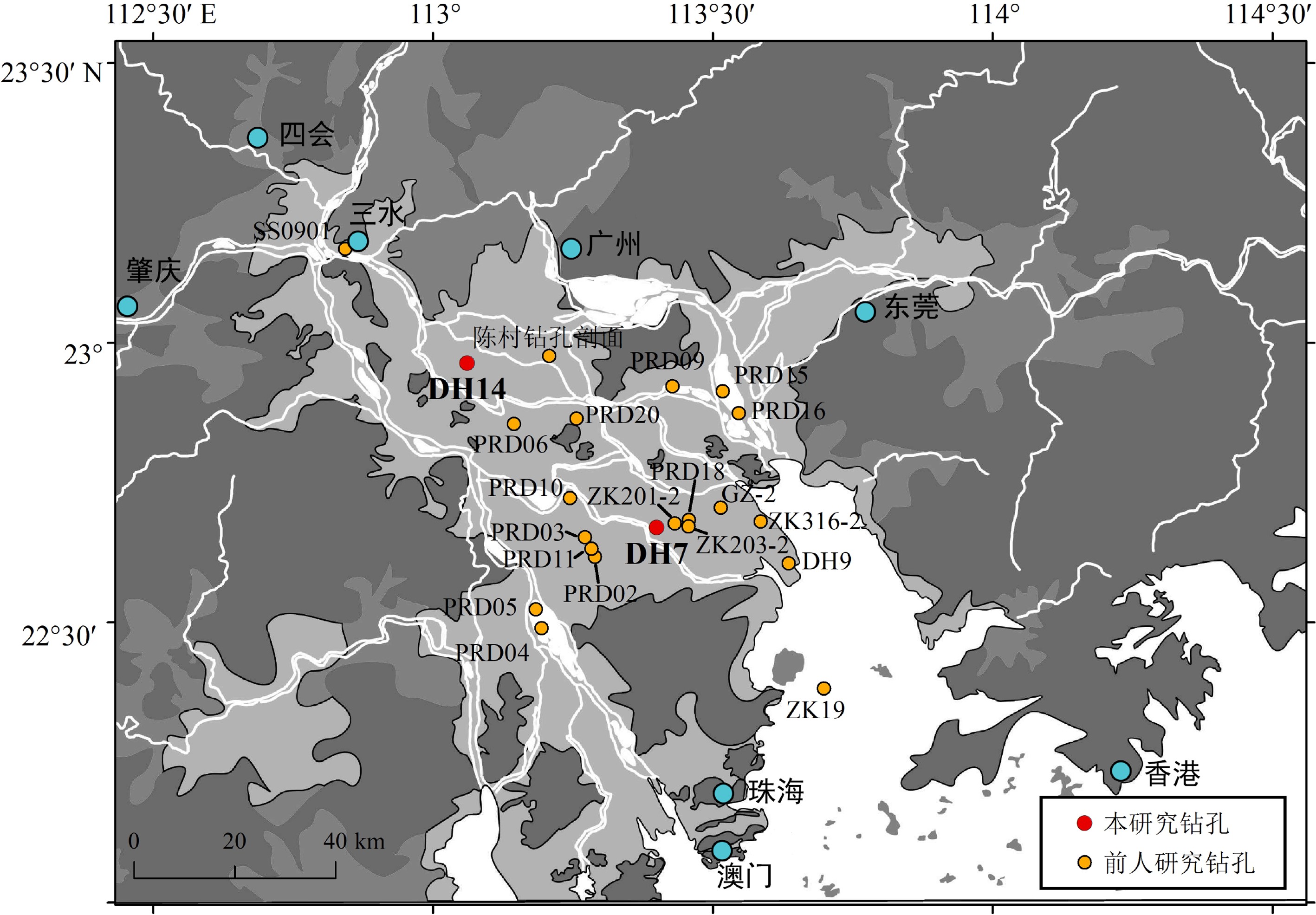
 下载:
下载:
